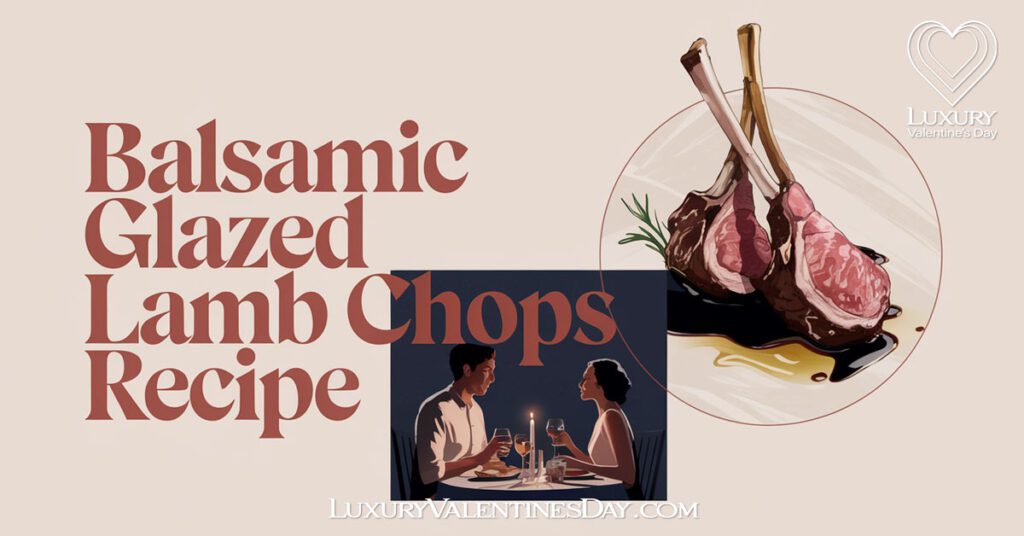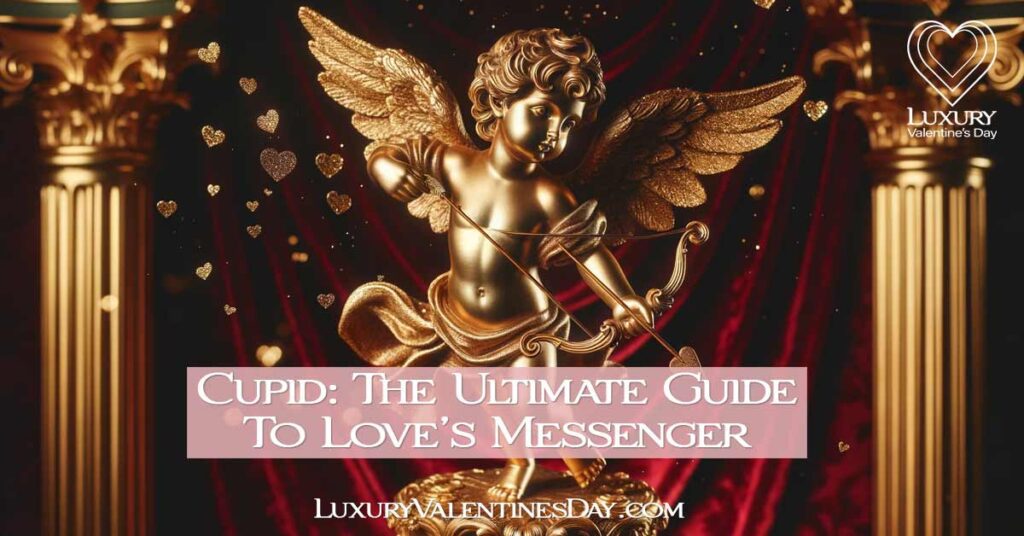
Table of Contents
ToggleWhy Cupid Matters: Unlocking the Secrets of Love’s Eternal Icon
Who is Cupid, and why has this cherubic figure captured our hearts for centuries? Get ready for a whirlwind tour that’s more than just arrows and heart-shaped cards. We’re diving into four fascinating realms: Cupid’s mythology, symbolism, cultural impact, and yes—even his love life.
Key Takeaways:
- Understand the mythology behind Cupid.
- Explore the symbolism of Cupid in society.
- Discover Cupid’s influence in art and culture.
- Uncover the mysteries of Cupid’s love life.
Where Does Cupid Come From? The Story Behind the Legend
The Mythology of Cupid
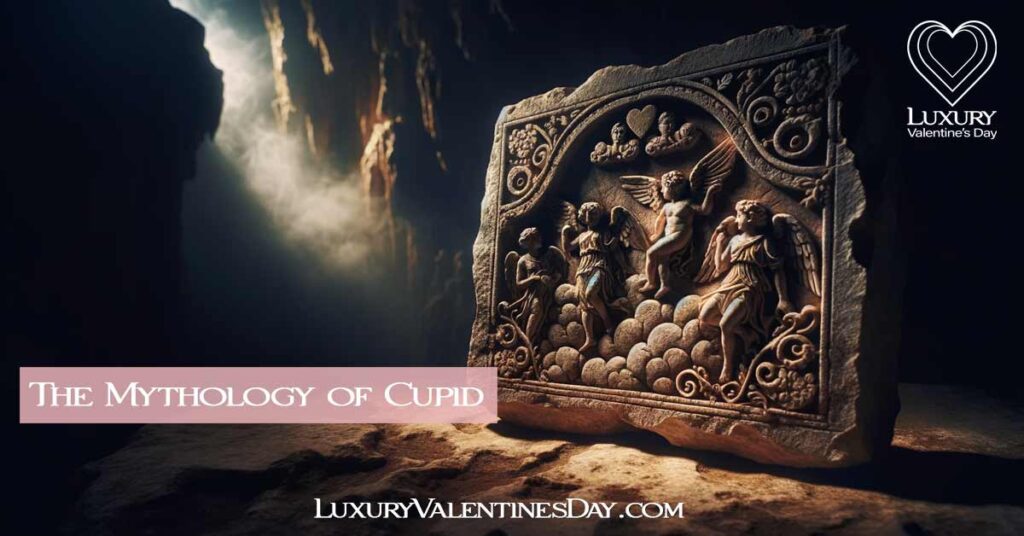
The Origins of Cupid
Think you know where Cupid comes from? Think again! We’re about to reveal whether this god of love is a Greek invention or a Roman import. And trust us, understanding Cupid’s origins will give you a whole new perspective on the history of Valentines.
The Greek Connection
First off, let’s talk about Eros. If you’re into Greek mythology, you’ve probably heard of him. Eros is often considered the Greek counterpart to Cupid, but let’s be clear—they’re not the same guy. Eros is sometimes depicted as one of the primordial gods born from Chaos. Yeah, that’s right, Chaos. Sounds intense, doesn’t it?
Here’s a quick comparison to set the record straight:
| Aspect | Cupid | Eros |
|---|---|---|
| Origin | Roman | Greek |
| Parentage | Venus & Mars | Chaos/Aphrodite |
| Attributes | Bow & Arrow | Torch, Bow & Arrow |
The Roman Influence
Now, let’s jet-set to Rome. In Roman mythology, Cupid is the son of Venus, the goddess of love, and Mars, the god of war. Quite the family, right? Unlike Eros, Cupid is often portrayed as a chubby boy, armed with a bow and arrow. The Romans had a knack for taking Greek gods and giving them a makeover, and Cupid was no exception.
Cultural Evolution
But wait, there’s more. Cupid didn’t just stay in the annals of Roman history. He evolved. Today, he’s not just a Roman or Greek figure but a universal symbol of love. You’ll find him in Renaissance art, modern-day Valentine’s cards, and even in pop culture references.
- Renaissance Art: Think of masterpieces where Cupid frolics with other gods.
- Modern-day Valentine’s Cards: He’s the poster child, literally.
- Pop Culture References: Ever heard a love song mentioning Cupid? You get the point.
The next time you see a Valentine’s Day card with Cupid, remember—he’s got a backstory that’s as complex as love itself.
The Tale of Cupid and Psyche
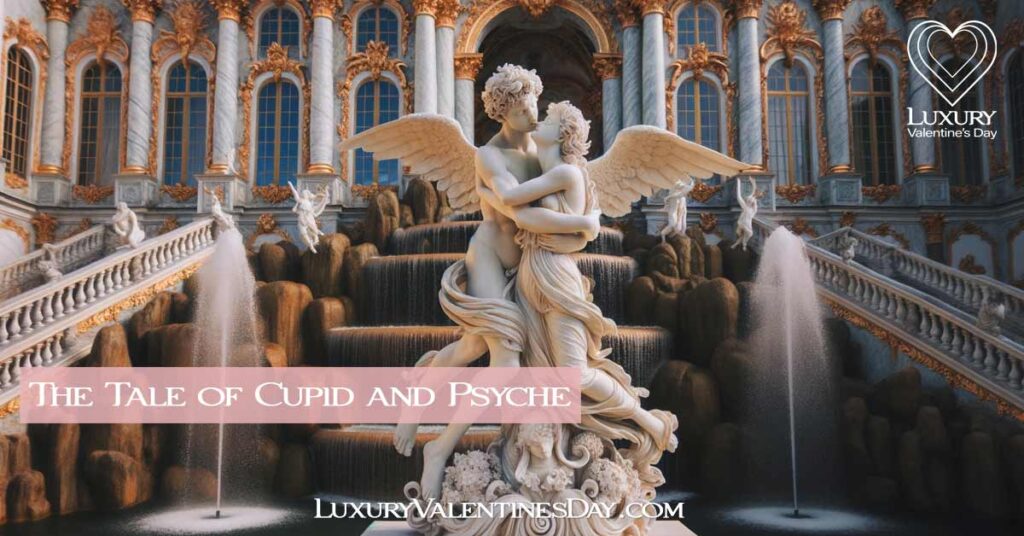
Ever heard of a love story that rivals Romeo and Juliet? Get ready, because the tale of Cupid and Psyche is the epic romance you’ve been missing out on.
Love at First Sight
When Cupid laid eyes on Psyche, he was so struck by her beauty that he dropped his arrow, pricking himself and falling deeply in love with her. Instead of following his mother Venus’ orders, Cupid became Psyche’s secret admirer.
Trials of Love
Psyche’s beauty was both a blessing and a curse. Although admired by all, she was so intimidating that no mortal man dared to marry her. Desperate for love, Psyche consulted an oracle who told her she was destined to marry a monster. Resigned to her fate, she was left on a mountaintop to await her monstrous husband. But Cupid, in disguise, had other plans. He whisked her away to a magical palace where he visited her only at night, keeping his identity a secret.
The Betrayal
Curiosity got the better of Psyche. Encouraged by her sisters, she lit a lamp one night to see her husband’s face. To her surprise and delight, her husband was not a monster but the beautiful god, Cupid. However, a drop of hot oil from the lamp awakened Cupid, who, feeling betrayed, fled back to the heavens.
The Quest for Redemption
Determined to win back her love, Psyche undertook a series of impossible tasks set by Venus. From sorting a room full of grains in a single night to fetching water from the River Styx, Psyche completed each task with divine intervention. Her final task was to go to the underworld and fetch a box of beauty from Persephone, the queen of the dead.
The Happy Ending
Psyche succeeded but couldn’t resist opening the box, hoping to gain some of Persephone’s beauty. Instead, she found deadly slumber. Cupid, who had been watching her struggles, could bear it no longer. He flew to her rescue, woke her with a kiss, and pleaded with Jupiter to make her immortal. The gods consented, and Cupid and Psyche were reunited, living happily ever after as gods of love.
There you have it—the tale of Cupid and Psyche, a love story that has stood the test of time, proving that true love knows no bounds.
The Parentage of Cupid
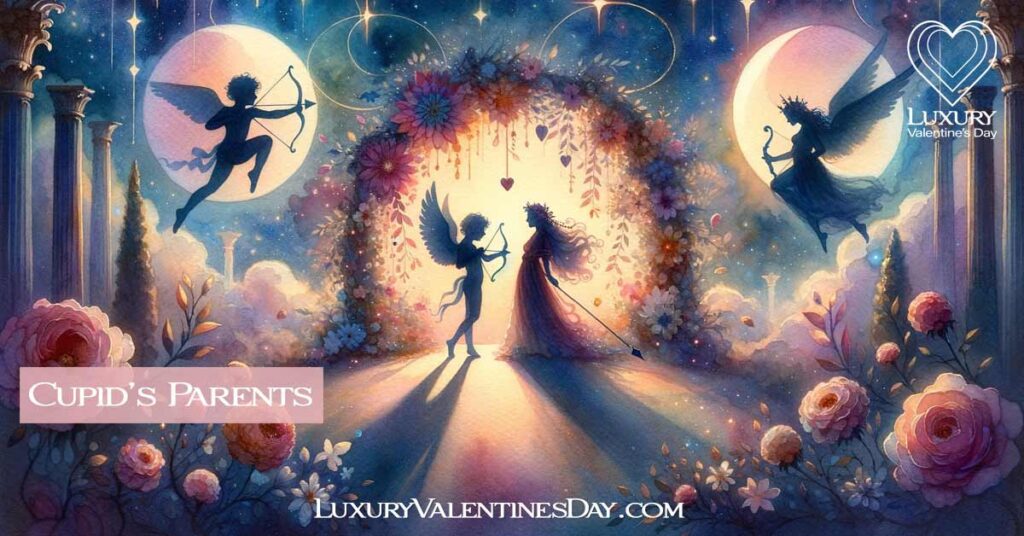
Is Cupid the son of Aphrodite or Venus? It’s a question that has puzzled scholars and enthusiasts alike. Let’s unravel this complex family tree and see what we find.
The Greek Lineage
In Greek mythology, Cupid is often equated with Eros, the god of love. Eros is usually considered the son of Aphrodite, the goddess of love and beauty, and either Ares, the god of war, or Hermes, the messenger of the gods. The Greeks had a more complex view of Eros, sometimes depicting him as a primordial god born from Chaos, the void from which all life sprang.
The Roman Family Tree
In Roman mythology, Cupid is decidedly the son of Venus, the goddess of love, and Mars, the god of war. The Romans were pretty clear about this lineage, often depicting Cupid in art and literature as a mischievous boy who took after both his warlike father and his loving mother.
The Blurred Lines
The confusion often arises because of the Roman habit of incorporating Greek gods into their own pantheon. While the Romans had Venus and Mars, the Greeks had Aphrodite and Ares. Over time, these mythologies blended, leading to some overlap and confusion.
Why It Matters
You might wonder, why does it matter who Cupid’s parents are? Well, understanding Cupid’s parentage gives us insights into his character. Is he a complex figure with a dual nature, reflecting both love and war? Or is he a simpler symbol of romantic love? Knowing his lineage helps us understand the different facets of love that Cupid represents.
Is Cupid the son of Aphrodite or Venus? The answer is both, depending on whether you’re looking through a Greek or Roman lens. But no matter the parentage, one thing is clear: Cupid continues to be a compelling symbol of love in all its complexity.
Eros vs. Cupid
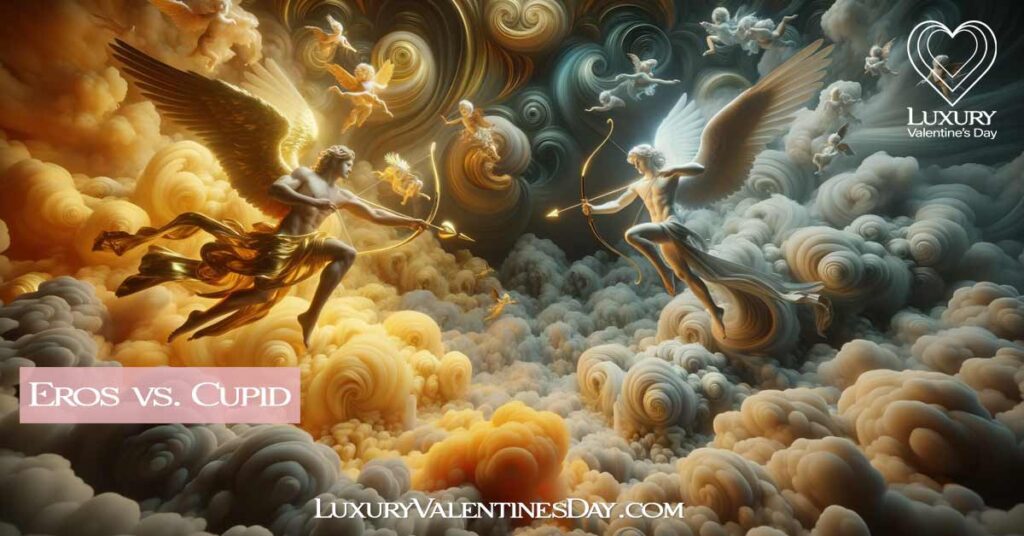
Eros and Cupid: two names that have been used interchangeably but represent different facets of love in Greek and Roman mythologies. Let’s break down the differences and similarities between these iconic figures of love.
Origin Stories
Eros hails from Greek mythology. Depending on the source, he’s either a primordial god born from Chaos or the son of Aphrodite and Ares. Eros is often depicted as a handsome young man, symbolizing not just romantic love but also a form of divine, creative force.
Cupid, on the other hand, is a Roman deity. He’s the son of Venus, the goddess of love, and Mars, the god of war. Unlike Eros, Cupid is often portrayed as a chubby child, focusing more on the playful and mischievous aspects of love.
Weapons of Choice
Both Eros and Cupid are known for their archery skills, but their weapons have different implications. Eros’ arrows come in two types: golden ones that instill love and leaden ones that sow aversion. Cupid’s arrows, however, are uniformly love-inducing, emphasizing his role as a simpler symbol of romantic love.
Roles in Mythology
Eros plays a more complex role in Greek mythology. He’s not just about romantic love; he also represents the creative force that binds the universe. His love can be both constructive and destructive, as seen in various myths where he either aids or hinders gods and mortals.
Cupid’s role is more straightforward. He’s the god of romantic love and desire. His actions, while sometimes causing trouble, generally aim to unite people in love.
Cultural Impact
Both figures have had a lasting impact on art, literature, and culture, but in different ways. Eros is often seen as a more mature, complex figure, appearing in philosophical works and high art. Cupid, with his childlike innocence, is a popular figure in Western art and is especially associated with Valentine’s Day.
Eros vs. Cupid at a Glance
| Aspect | Eros | Cupid |
|---|---|---|
| Origin | Greek | Roman |
| Parentage | Aphrodite & Ares/Hermes | Venus & Mars |
| Attributes | Golden and leaden arrows | Bow & Arrow |
| Role | Complex, divine force | Romantic love |
| Cultural Impact | Philosophical works, high art | Popular art, Valentine’s Day |
While Eros and Cupid may seem similar at first glance, they are distinct characters with their own unique stories, roles, and impacts on culture. Understanding these differences enriches our view of how love has been represented across civilizations.
The Symbolism of Cupid
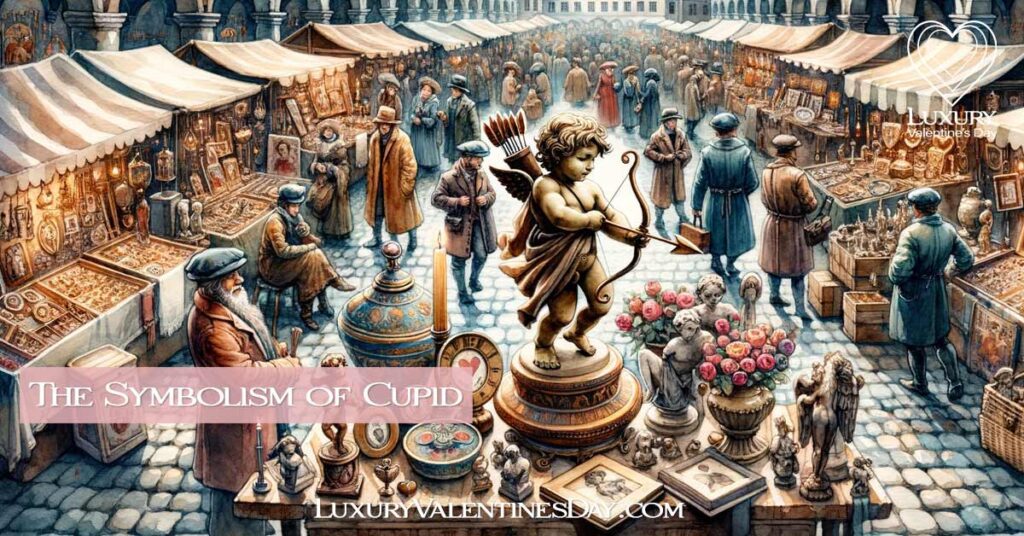
What does Cupid represent in mythology? Have you ever wondered why Cupid, with his chubby cheeks and mischievous smile, has become the universal symbol of love? Prepare to go beyond the surface as we delve into the intricate symbolism of Cupid, revealing how this iconic figure has captivated hearts and minds for centuries.
Symbolism of Cupid in Mythology
What does Cupid represent in mythology? He’s a complex figure that embodies the many facets of love, from its intentional nature to its fleeting moments, from its joys to its sorrows. Understanding the symbolism of Cupid enriches our own understanding of love, making us appreciate its complexity and beauty.
| Symbol | Meaning |
|---|---|
| Bow and Arrow | Intention and direction of love |
| Wings | Fleeting nature of love |
| Dual Nature | Joy and sorrow in love |
| Cultural Evolution | Changing views of love over time |
The Bow and Arrow
Cupid’s most famous attribute is his bow and arrow, but have you ever stopped to think about what they symbolize? The bow represents intention, while the arrow symbolizes the direction or aim of love. When Cupid shoots his arrow, he’s not just causing infatuation; he’s directing love where he thinks it should go. It’s a powerful metaphor for the intentional and sometimes unpredictable nature of love.
The Wings
Cupid is often depicted with wings, and they’re not just for show. The wings symbolize the fleeting and transient nature of love. Just as Cupid can fly into our lives unexpectedly, so can love. And just as quickly, it can fly away. It’s a reminder to appreciate love when we have it and to understand its ephemeral nature.
Dual Nature
Cupid is often portrayed as both playful and mischievous, embodying the dual nature of love itself. Love can bring immense joy and happiness, but it can also lead to heartbreak and sorrow. This duality is captured perfectly in the character of Cupid, who can be both a benevolent matchmaker and a mischievous troublemaker.
Cultural Evolution
Cupid’s symbolism has evolved over time, adapting to the cultural and societal norms of different eras. In Renaissance art, he was often depicted as a symbol of passionate love, while in modern times, he’s more associated with romantic and often commercialized love, especially around Valentine’s Day.
Cupid & Valentine’s Day

Why is Cupid the poster child for Valentine’s Day? It’s a question that invites us to look at the history, the marketing, and the universal appeal of this iconic figure. Let’s unravel the mystery.
The Historical Connection
Believe it or not, Cupid’s association with Valentine’s Day isn’t as ancient as you might think. While Cupid has been a symbol of love for centuries, his connection to Valentine’s Day began to solidify in the Middle Ages. This was a time when the concept of romantic love was gaining traction, and what better figure to represent this than Cupid?
The Commercial Angle
Fast forward to the 19th century, and we see Cupid starting to appear on the first mass-produced Valentine’s Day cards. His cherubic image was perfect for selling the idea of love, and marketers seized the opportunity. Today, Cupid is a staple on cards, chocolates, and all sorts of Valentine’s Day merchandise.
The Universal Appeal
Cupid’s widespread appeal lies in his simplicity. He’s easy to understand—a cherub with a bow and arrow who makes people fall in love. This universal concept of love is something that resonates with people of all ages and cultures, making Cupid an ideal symbol for a holiday that celebrates love on a global scale.
The Emotional Resonance
Let’s not forget the emotional aspect. Cupid, with his innocent antics and love-inducing arrows, evokes a sense of nostalgia, innocence, and hope. He reminds us of the simple yet profound joy of falling in love, making him a comforting and relatable figure for many.
Why Cupid is Synonymous with Valentine’s Day
| Factor | Explanation |
|---|---|
| Historical Connection | Roots in the Middle Ages’ concept of romantic love |
| Commercial Angle | Popularized through mass-produced Valentine’s cards |
| Universal Appeal | Easy-to-understand symbol resonates globally |
| Emotional Resonance | Evokes feelings of nostalgia, innocence, and hope |
So, why is Cupid the poster child for Valentine’s Day? It’s a combination of historical evolution, commercial savvy, universal appeal, and emotional resonance. This multi-faceted relationship between Cupid and Valentine’s Day offers a fascinating glimpse into how symbols and traditions evolve over time.
The Arrow’s Tale
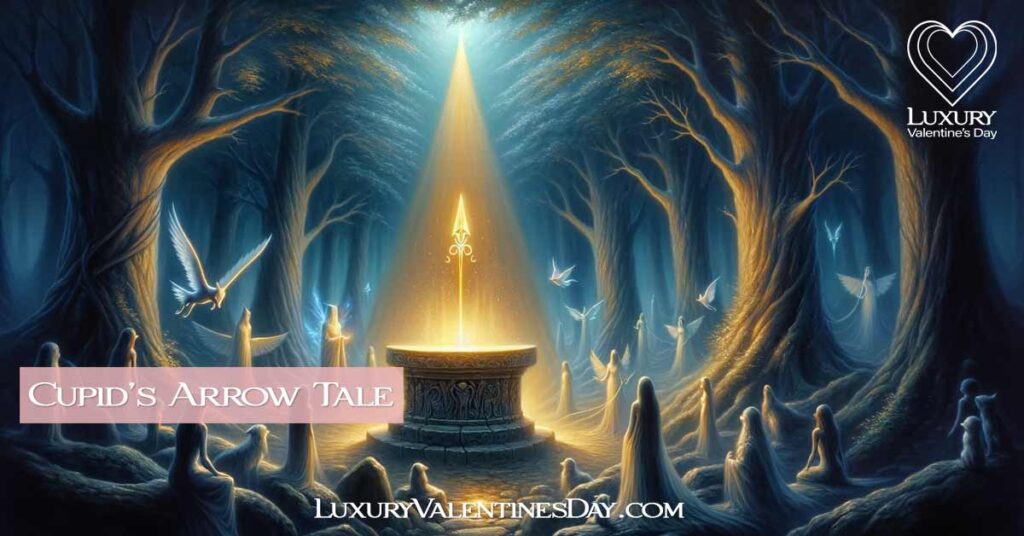
What’s the real story behind Cupid’s arrow? It’s not just a pointy stick that makes people fall head over heels. The arrow has layers of meaning that reveal the complexities of love and desire. Let’s take aim and explore.
The Anatomy of the Arrow
First, let’s break down the arrow itself. The shaft represents the journey of love, while the point symbolizes the moment love strikes. The fletching, or feathers at the end, help guide the arrow to its destination, much like how destiny or fate guides love in many beliefs.
The Golden and Leaden Arrows
In some myths, especially those related to Eros, there are two types of arrows: golden and leaden. The golden arrows inspire love and desire, while the leaden arrows instill aversion and repulsion. This duality reflects the complexities of love, which can bring both joy and sorrow.
The Arrow as a Catalyst
Cupid’s arrow serves as a catalyst, sparking the initial attraction or feeling that can grow into something more profound. It’s not just about romantic love; the arrow can also symbolize other forms of love, like platonic or familial love. The arrow initiates the process but doesn’t guarantee the outcome, reminding us that love is both spontaneous and unpredictable.
The Arrow in Literature and Art
Cupid’s arrow has been a popular motif in literature and art, often used to symbolize the inescapable power of love. From Shakespearean plays to Renaissance paintings, the arrow represents love’s ability to conquer all, even when faced with obstacles and challenges.
The Symbolism of Cupid’s Arrow
| Element | Symbolism |
|---|---|
| Anatomy of the Arrow | Journey, moment, and guidance in love |
| Types of Arrows | Golden for love, leaden for aversion |
| Role as Catalyst | Initiates various forms of love |
| Cultural Impact | Popular motif in literature and art |
What’s the real story behind Cupid’s arrow? It’s a symbol rich in meaning, representing the journey, the moment, and the guiding forces of love. Understanding the deeper symbolism of the arrow gives us a more nuanced view of love, in all its beautiful complexity.
The Many Faces of Cupid

Is Cupid an angel, a cherub, or something else? It’s a question that has intrigued artists, theologians, and lovers alike. Let’s dive into the many faces of Cupid to find out.
Cupid as an Angel
In some interpretations, especially in Christian art, Cupid is depicted as an angel. This portrayal aligns him with divine love and heavenly intervention. However, it’s worth noting that in Christian theology, angels are messengers of God and don’t possess free will, which contrasts with Cupid’s more mischievous and willful nature.
Cupid as a Cherub
The cherubic image of Cupid is perhaps the most popular. With his chubby cheeks and playful demeanor, this portrayal emphasizes the innocent and childlike aspects of love. The term “cherub” originally referred to a much more fearsome creature in biblical texts, but over time it has come to symbolize innocence and purity, making it a fitting form for Cupid.
Cupid in Classical Mythology
In classical Greek and Roman mythology, Cupid (or Eros) is neither an angel nor a cherub. He’s a god with his own set of powers and limitations. Depending on the myth, he can be a primordial force or the child of deities, embodying various aspects of love, from the romantic to the erotic.
Cupid in Popular Culture
In modern times, Cupid has taken on a more commercialized form, especially around Valentine’s Day. He’s often depicted as a cute, harmless figure who brings people together, a far cry from the more complex god of classical myths.
The Many Interpretations of Cupid
| Interpretation | Characteristics |
|---|---|
| Angel | Divine love, heavenly messenger |
| Cherub | Innocence, childlike aspects of love |
| Classical Mythology | Complex god with various forms of love |
| Popular Culture | Commercialized, simplified symbol of love |
Is Cupid an angel, a cherub, or something else? The answer is that he can be all of these and more, depending on the cultural, religious, or historical lens through which you view him. Understanding these various interpretations enriches our own understanding of love and the many forms it can take.
The Cupid Effect
Ever heard of the “Cupid Effect“? No, it’s not just the warm fuzzies you get when you’re in love. It’s the influence Cupid has on love, relationships, and even the luxury market. Let’s take a closer look.
The Love Market
First off, let’s talk about how Cupid influences love. His arrows don’t just spark romance; they also fuel a multi-billion-dollar industry. Think about it: engagement rings, romantic getaways, lavish weddings. Cupid’s got his chubby little fingers in all these pies, making him a key player in the love market.
The Luxury Angle
Now, let’s talk bling. Cupid isn’t just about love; he’s also about luxury. Think of the high-end gifts exchanged on Valentine’s Day, from designer jewelry to gourmet chocolates. Cupid’s image often graces these luxury items, adding an extra layer of allure and desirability.
The Experience Factor
Cupid also influences the luxury experience market. Romantic dinners at Michelin-starred restaurants, couples’ spa days, and exotic getaways are often marketed with Cupid imagery, emphasizing the idea that love is best celebrated in style.
The Emotional Investment
Beyond material goods and experiences, the “Cupid Effect” also influences emotional investment. The idea that love should be grand, passionate, and all-consuming is often attributed to the romantic scenarios Cupid sets up with his arrows. This emotional grandeur often translates into a desire for luxurious experiences and items that reflect the depth of one’s feelings.
The Cupid Effect in Numbers
| Sector | Estimated Value (in billions) |
|---|---|
| Jewelry | $80 |
| Romantic Getaways | $30 |
| Luxury Dining | $20 |
| High-end Gifts | $15 |
What is the “Cupid Effect“? It’s the influence that this iconic figure has on both love and luxury, driving markets and shaping cultural perceptions of what love should look like. Understanding this effect gives us a unique insight into the commercial and emotional aspects of love in modern society.
The Anatomy of Cupid
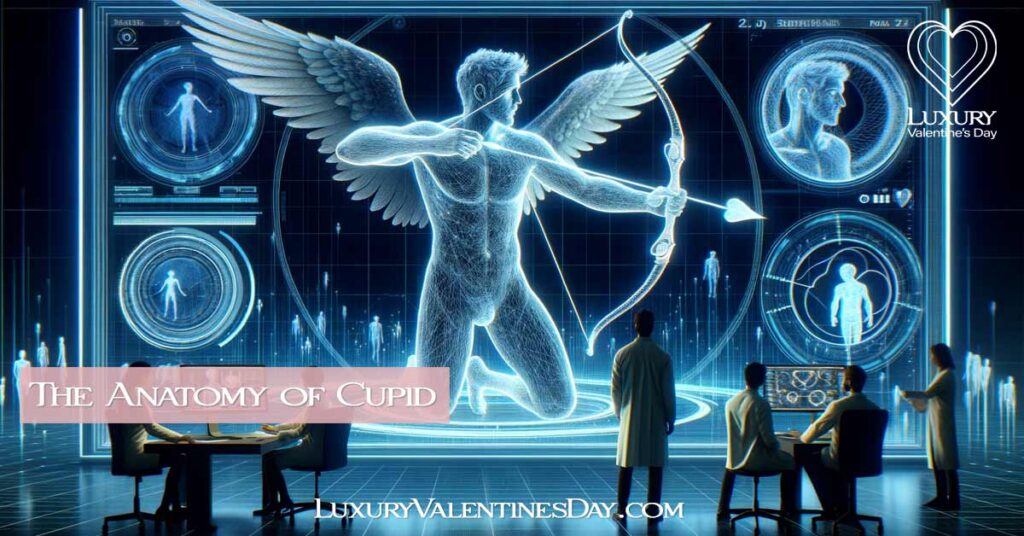
Does Cupid have wings? It’s a question that might seem straightforward, but the answer reveals layers of meaning about love, desire, and the human condition. Let’s take flight and explore.
The Symbolism of Wings
First off, yes, Cupid is most commonly depicted with wings. But why? The wings symbolize the ethereal and transient nature of love. Just as Cupid can fly in and out of our lives, so can love. The wings remind us that love is not bound by earthly limitations and can touch us when we least expect it.
The Variability of Wings
Interestingly, the depiction of Cupid’s wings can vary. Sometimes they’re angelic and feathered, other times more like a butterfly’s, symbolizing transformation. The different types of wings offer various interpretations of love, from the divine to the transformative.
The Weight of Love
Despite his wings, Cupid is often depicted as a chubby cherub. This interesting contrast between his weight and his ability to fly symbolizes the paradox of love: it can feel both heavy and uplifting, burdensome and liberating.
The Absence of Wings
In some artistic representations, especially in classical art, Cupid is shown without wings. This version emphasizes the more earthly, sensual aspects of love, reminding us that while love can be heavenly, it also has very human dimensions.
The Anatomy of Cupid’s Wings
| Aspect | Symbolism |
|---|---|
| Feathered Wings | Divine, ethereal aspects of love |
| Butterfly Wings | Transformation and change |
| Chubby Form | The paradox of love’s weight and lightness |
| Absence of Wings | Earthly, sensual dimensions of love |
So, does Cupid have wings? Yes, and those wings carry a multitude of meanings, from the ethereal to the earthly, from the uplifting to the burdensome. Understanding the anatomy of Cupid’s wings gives us a richer, more nuanced view of love’s complexities.
Cupid in Art and Culture

Have you ever wondered why Cupid graces the halls of the Louvre or pops up in your favorite pop songs? Get ready to embark on a captivating journey through art and culture as we explore the many ways Cupid has been immortalized. From classical masterpieces to contemporary interpretations, we’ll uncover how Cupid has shaped and been shaped by human creativity.
Cupid in Art

Ever looked at a Renaissance painting and wondered, “Is that Cupid or a Putto?” You’re not alone. These two figures are often used interchangeably, but they have distinct identities and roles in art. Let’s brush up on our art history and set the record straight.
The Classical Cupid
In classical art, especially from the Renaissance period, Cupid is often depicted as a youthful male figure with wings, a bow, and an arrow. He’s usually involved in scenes of love or desire, emphasizing his role as the god of love. His presence in a painting often adds layers of meaning related to love, passion, or even danger.
The Putto: More Than Just a Cute Face
On the other hand, a Putto (plural: Putti) is also a chubby, winged child, but it doesn’t carry a bow and arrow. Originating from classical antiquity, Putti were revived in Renaissance art to serve as decorative elements. They’re often seen in religious, mythological, and even secular art, but they don’t have the same love-inducing role as Cupid.
The Confusion
The confusion between Cupid and Putto often arises because both are winged and youthful. However, the key difference lies in their attributes and the context in which they appear. Cupid is more specific to themes of love and desire, while Putti have a broader range of roles in art.
The Modern Take
In contemporary art, the lines between Cupid and Putto have blurred even further, often being used more for aesthetic than symbolic purposes. However, understanding their historical roles can enrich our appreciation of art, adding layers of meaning to what might initially seem like simple decorative elements.
Cupid vs. Putto in Art
| Attribute | Cupid | Putto |
|---|---|---|
| Origin | Classical mythology | Classical antiquity |
| Attributes | Bow and arrow | None specific |
| Themes | Love, desire | Varied, often decorative |
| Context | Usually romantic or erotic scenes | Religious, mythological, or secular art |
Is it Cupid or a Putto? The next time you’re admiring a piece of art, take a closer look. Understanding the difference between these two figures can offer a richer, more nuanced art-viewing experience.
The Louvre’s Love Affair

Ever strolled through the Louvre and wondered where you could find the legendary lovebirds, Cupid and Psyche? Well, you’re in for a treat. Let’s navigate the labyrinthine halls of this iconic museum to find this masterpiece.
The Sculpture’s Location
First things first, where is it? The sculpture of Cupid and Psyche is located in the Denon Wing, one of the three wings of the Louvre. Specifically, you’ll find it in Room 403, also known as the Salle des Caryatides. It’s a room that’s as grand as the sculpture itself, adding to the overall experience.
The Artistic Marvel
The sculpture is a true marvel, capturing the intimate moment when Cupid awakens Psyche with a kiss. Created by Antonio Canova, an Italian sculptor, in the late 18th century, it’s a masterpiece of Neoclassical art. The intricate details, from the delicate wings of Cupid to the flowing drapery of Psyche, make it a must-see.
The Historical Context
Why is this sculpture in the Louvre, you ask? Well, it has a rich history. It was acquired by Joachim Murat, a Marshal of France, during the Napoleonic era and eventually made its way to the Louvre, where it has been enchanting visitors ever since.
The Emotional Impact
Beyond its artistic and historical significance, the sculpture also has a profound emotional impact. It captures the essence of romantic love—vulnerable, intimate, and eternal. It’s a piece that resonates with anyone who has ever been in love, making it a highlight of any Louvre visit.
Finding Cupid and Psyche in the Louvre
| Aspect | Details |
|---|---|
| Location | Denon Wing, Room 403 (Salle des Caryatides) |
| Artist | Antonio Canova |
| Style | Neoclassical |
| Historical Context | Acquired during the Napoleonic era |
The next time you find yourself wandering through the Louvre, make a beeline for the Denon Wing. The sculpture of Cupid and Psyche is not just an artistic masterpiece; it’s a celebration of love that transcends time and space.
The Evolution of Cupid
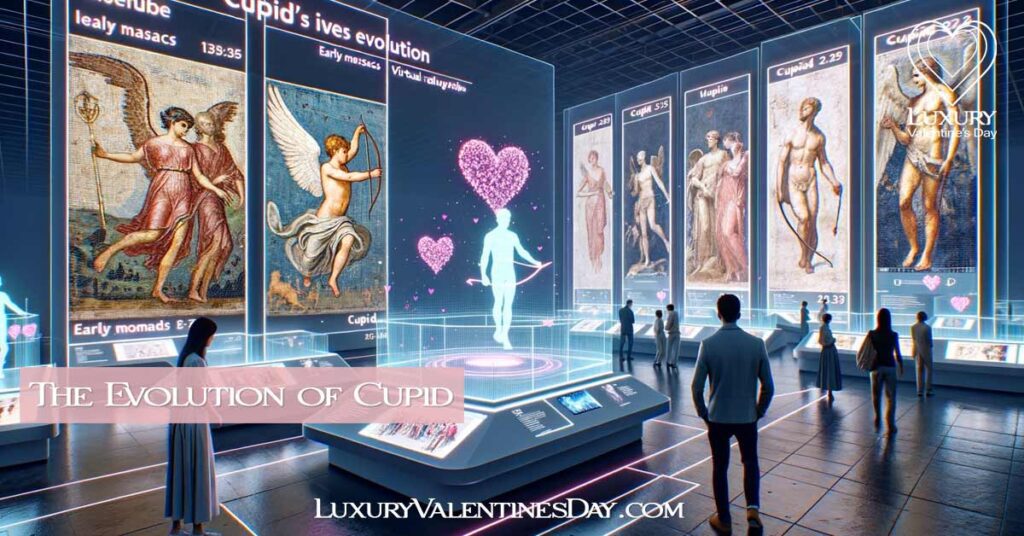
Who invented Cupid? It’s a question that takes us on a fascinating journey through time, from ancient civilizations to modern pop culture. Let’s unravel the mystery.
The Ancient Roots
Cupid’s origins can be traced back to ancient civilizations. In Greek mythology, he was known as Eros, the son of Aphrodite, the goddess of love. In Roman mythology, he became Cupid, the son of Venus. These ancient myths laid the foundation for the Cupid we know today.
The Renaissance Revival
Fast forward to the Renaissance, and Cupid experiences a revival. Artists like Botticelli and Michelangelo bring him back to life in their works, often depicting him as a mischievous, winged youth. This period solidified Cupid’s place in Western art and culture.
The Christian Influence
With the rise of Christianity, Cupid underwent another transformation. He was often portrayed as an angelic figure, representing divine love, especially in Christian art. This added a new layer of complexity to his character, aligning him more closely with heavenly themes.
The Modern Cupid
In modern times, Cupid has become a commercial symbol, especially around Valentine’s Day. He’s often depicted as a cute, chubby cherub who shoots arrows to make people fall in love. This contemporary version is far removed from the complex god of ancient myths but has widespread recognition.
The Evolution of Cupid
| Era | Characteristics |
|---|---|
| Ancient | Known as Eros in Greek, Cupid in Roman mythology |
| Renaissance | Revived in art, often as a mischievous youth |
| Christian Era | Portrayed as an angelic figure |
| Modern Times | Commercial symbol, especially for Valentine’s Day |
The invention of Cupid is not the work of a single individual or culture. He is a composite, shaped by various influences over the centuries. Understanding this evolution enriches our view of this iconic figure, revealing him as a complex symbol that has captured human imagination for millennia.
The Language of Love

Ever wondered how to say “Cupid” in different languages? It’s not just a lesson in linguistics; it’s a testament to how universal the concept of love is. Let’s dive into the many names of Cupid around the world.
Romance Languages
In languages that have Latin roots, the name stays relatively close to the original. For instance, in French, it’s “Cupidon,” and in Spanish, it’s “Cupido.” These names echo the Roman origins of the figure.
Greek Origins
In Greek, the equivalent of Cupid is “Eros,” which is actually the original name for this god of love. It’s fascinating to see how the name has both changed and stayed the same, depending on the cultural context.
Asian Languages
In languages like Chinese and Japanese, the name for Cupid translates to phrases that mean “the god of love.” In Chinese, it’s “Ài Shén,” and in Japanese, it’s “Ai no Kami.”
Slavic Languages
In Russian and other Slavic languages, the name for Cupid often translates to “Amur,” which is derived from “Amore,” the Italian word for love. It’s a nod to the universality of the character.
Saying “Cupid” in Different Languages
| Language | Translation |
|---|---|
| French | Cupidon |
| Spanish | Cupido |
| Greek | Eros |
| Chinese | Ài Shén |
| Japanese | Ai no Kami |
| Russian | Amur |
The name “Cupid” may change from language to language, but the essence remains the same. This linguistic journey reveals how the concept of love, embodied by Cupid, is a universal human experience.
The Cultural Impact of Cupid

Is Cupid overrated? It’s a provocative question that invites us to examine the cultural impact of this ubiquitous symbol of love. Let’s dive in and see if Cupid is worth all the attention he gets.
The Commercial Cupid
First, let’s talk about the commercial aspect. Cupid is everywhere during Valentine’s Day, from greeting cards to chocolate boxes. But is he just a marketing gimmick? Some argue that the commercialization of Cupid dilutes his original, more complex symbolism.
The Pop Culture Presence
Cupid also has a significant presence in pop culture, from movies to songs. While this has made him more accessible, it has also led to a simplified, often clichéd representation. Does this pop culture portrayal do justice to the multi-layered figure from mythology?
The Love Debate
Then there’s the love angle. Cupid is supposed to be the god of love, but what kind of love? Is it just romantic love, or does it encompass other forms of love like platonic or familial love? The narrow focus on romantic love could be seen as limiting.
The Skeptic’s View
Some skeptics argue that Cupid is overrated because he represents an idealized, unrealistic view of love. They claim that real love is more complex and less whimsical than the instant attraction Cupid’s arrow is said to induce.
The Debate on Cupid’s Cultural Impact
| Argument | For Cupid | Against Cupid |
|---|---|---|
| Commercialization | Increases visibility | Dilutes symbolism |
| Pop Culture | Makes him accessible | Leads to clichés |
| Types of Love | Focuses on romantic love | Limits understanding |
| Realism | Idealizes love | Unrealistic expectations |
Is Cupid overrated? The answer depends on how you view his cultural impact. While he has been commercialized and simplified, he also continues to be a powerful symbol of love that resonates with many. The debate is open, and perhaps that’s what makes Cupid eternally fascinating.
The Love Life of Cupid
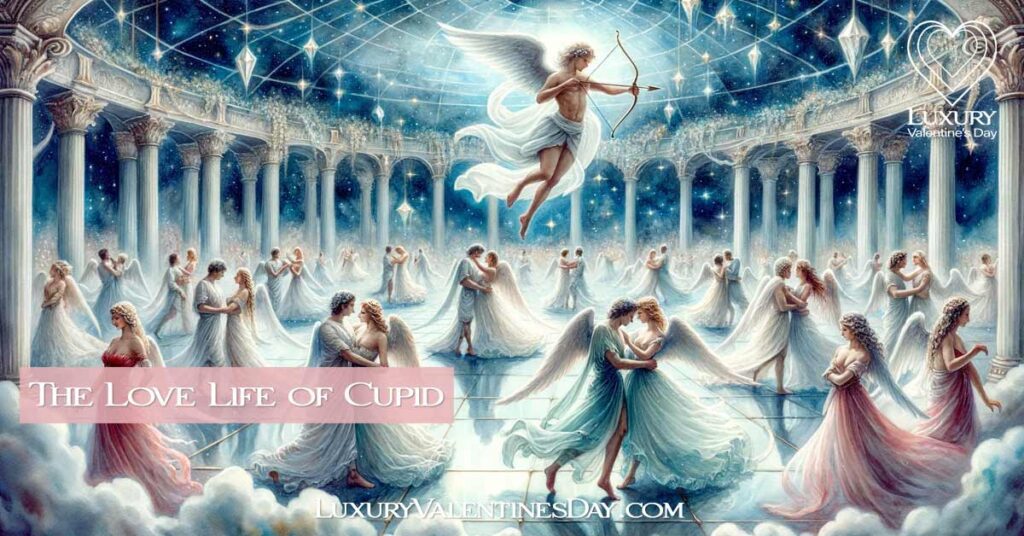
Think you know everything about love? Wait until you hear about Cupid’s own romantic escapades. From his legendary love affair with Psyche to the mysteries surrounding his love life, we’re about to delve into the heart of the matter. Get ready to uncover the ironies, the passions, and the untold stories of Cupid’s love life.
Cupid’s Love Interests
Cupid, the god of love, has a love life of his own that’s as intriguing as the countless romances he’s sparked. So, who has caught the eye of this celestial matchmaker? Let’s find out.
The Legendary Psyche
First and foremost, there’s Psyche, the mortal woman who became Cupid’s wife. Their love story is the stuff of legends, filled with trials, tribulations, and ultimately, eternal love. Psyche had to go through a series of impossible tasks to win Cupid’s heart, proving that even gods aren’t immune to the complexities of love.
The Goddess Venus
While not a romantic interest, Venus, Cupid’s mother, plays a significant role in his love life. She’s often portrayed as being jealous of his affections, especially towards Psyche, adding a layer of familial drama to his romantic escapades.
Other Mythological Figures
In various myths and adaptations, Cupid has been linked to other figures, though none as prominently as Psyche. These fleeting romances often serve to highlight his impulsive nature and the transient quality of love.
The Modern Interpretation
In contemporary stories and media, Cupid is often portrayed as a playful, sometimes mischievous figure who flits from one love interest to another. While these portrayals may not be canon, they add a modern twist to his ancient love life.
Cupid’s Love Interests
| Love Interest | Relationship Status | Notable Aspects |
|---|---|---|
| Psyche | Wife | Legendary love story |
| Venus | Mother | Familial drama |
| Various Figures | Fleeting Romances | Highlights transient love |
Cupid’s love life is a tapestry woven from threads of myth, drama, and passion. From his enduring love for Psyche to his more transient romances, Cupid’s own love life is as complex and fascinating as the relationships he influences.
The Psyche Connection
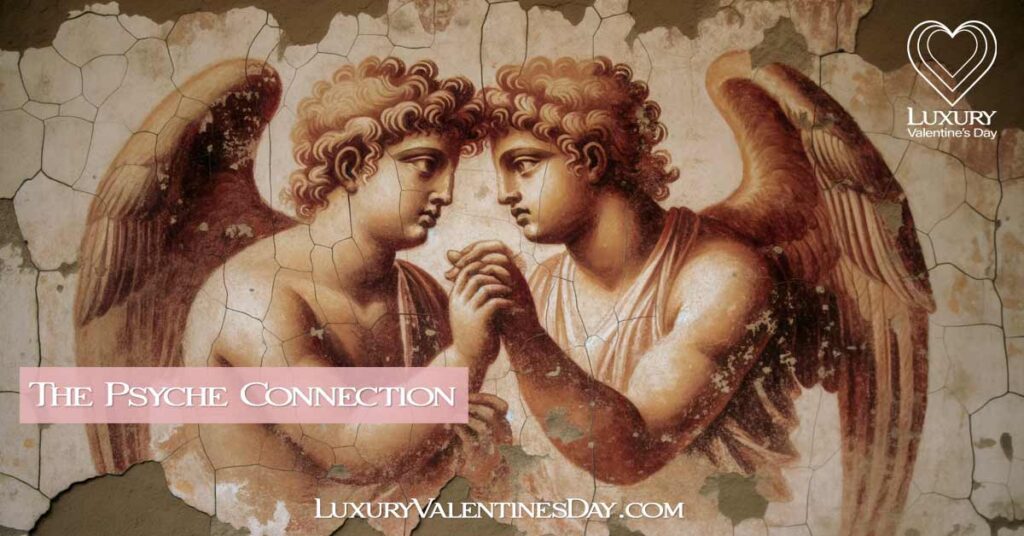
How did Cupid, the god who makes everyone else fall in love, fall for Psyche? It’s a tale that’s as enchanting as it is complex. Buckle up, because we’re about to explore one of mythology’s greatest love stories.
Love at First Sight?
Ironically, Cupid fell for Psyche when he was sent by his mother, Venus, to make her fall in love with someone else. Upon seeing her, he was so struck by her beauty that he accidentally pricked himself with his own arrow. Talk about an occupational hazard!
The Trials of Love
Their love story wasn’t all smooth sailing. Psyche had to undergo a series of grueling tasks set by Venus to win back Cupid after she betrayed his trust. From sorting grains to fetching water from the River Styx, her trials were Herculean but her love was unwavering.
The Divine Intervention
Eventually, even the gods couldn’t stand in the way of true love. Jupiter, the king of gods, intervened and granted Psyche immortality, allowing her to be with Cupid forever. It was a divine seal of approval on their love.
The Lasting Legacy
The love story of Cupid and Psyche has been told and retold for centuries, inspiring countless works of art, literature, and even psychology—Carl Jung used the term “anima” and “animus” to describe the inner Psyche and Cupid in all of us.
Key Moments in Cupid and Psyche’s Love Story
| Event | Description |
|---|---|
| First Encounter | Cupid pricks himself with his own arrow |
| Trials | Psyche undergoes tasks set by Venus |
| Divine Approval | Jupiter grants Psyche immortality |
| Legacy | Continues to inspire art, literature, and psychology |
Cupid’s love for Psyche is a tale that transcends time, culture, and even divinity. It’s a love story that proves even gods can be vulnerable when it comes to matters of the heart.
The Irony of Love
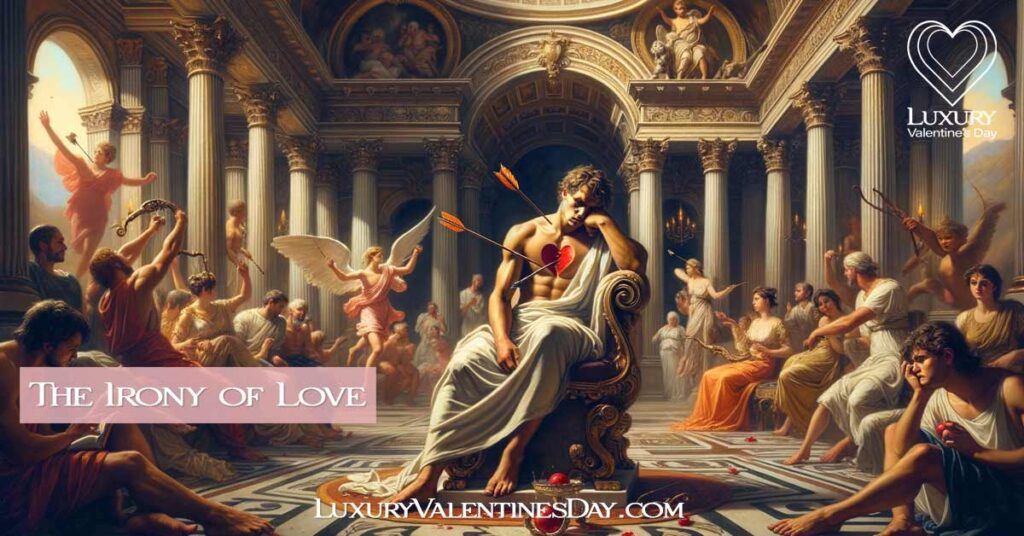
Can Cupid, the god who shoots arrows to make others fall in love, actually fall in love himself? It’s a question that’s as ironic as it is thought-provoking. Let’s unravel this paradox.
The Conceptual Irony
Firstly, let’s acknowledge the irony in the concept itself. Cupid, as the god of love, is supposed to be the instigator of romantic feelings, not the recipient. It’s like the matchmaker getting caught in his own web of romance. Intriguing, isn’t it?
The Mythological Evidence
In mythology, Cupid does indeed fall in love, most notably with Psyche. This proves that even gods aren’t immune to their own powers. It adds a layer of complexity to his character, making him more relatable and less of an abstract concept.
The Philosophical Angle
From a philosophical standpoint, the idea of Cupid falling in love raises questions about the nature of love itself. Is love a universal experience that even divine beings can’t escape? Or is it a human construct that we’ve imposed on our gods?
The Cultural Impact
This irony has not been lost on artists, writers, and thinkers throughout history. The notion of Cupid falling in love has been explored in various forms of art and literature, often as a way to examine the complexities and contradictions of love.
Table: Exploring the Irony of Cupid’s Love
| Aspect | Details |
|---|---|
| Conceptual Irony | God of love falling in love |
| Mythological Evidence | Cupid’s love for Psyche |
| Philosophical Angle | Questions about the nature of love |
| Cultural Impact | Explored in art and literature |
The irony of Cupid falling in love adds a fascinating dimension to his character and to our understanding of love itself. It’s a paradox that makes us question, ponder, and most importantly, feel.
Cupid : The Mystery Lover
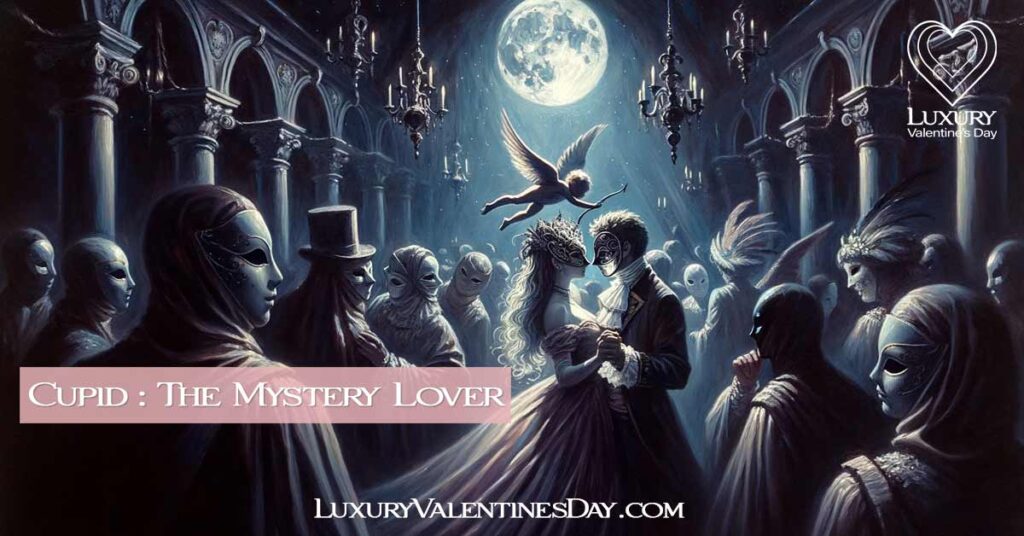
Does Cupid, the god of love, have a secret lover? It’s a question that’s sparked curiosity and fueled countless stories. Let’s dive into this enigmatic aspect of Cupid’s romantic life.
The Mythological Possibilities
While Psyche is the most famous love interest of Cupid, mythology is often open to interpretation. Various myths hint at other possible romantic entanglements, though none are as well-documented as his love for Psyche.
The Literary Interpretations
In literature, Cupid is often portrayed as a complex character with multiple love interests. From Shakespearean plays to modern novels, the idea of Cupid having a secret lover has been a recurring theme, adding layers of complexity to his persona.
The Pop Culture Angle
In movies, TV shows, and even video games, Cupid is sometimes depicted as having a mysterious lover, often as a plot twist. While these portrayals may not be canon, they do add an element of intrigue to his character.
The Fan Theories
Let’s not forget the fan theories. The internet is rife with speculation about Cupid’s secret lover. From goddesses to mortals to mythical creatures, the theories are as varied as they are imaginative.
The Mystery of Cupid’s Secret Lover
| Source | Speculation |
|---|---|
| Mythology | Hints at other romantic entanglements |
| Literature | Recurring theme of a secret lover |
| Pop Culture | Plot twists in movies and TV shows |
| Fan Theories | Varied and imaginative speculations |
Does Cupid have a secret lover? While there’s no definitive answer, the question itself adds a layer of mystery and allure to his already captivating character. It’s a romantic riddle that continues to fascinate, leaving us all wondering what lies in the hidden chambers of Cupid’s heart.
The Mechanics of Love
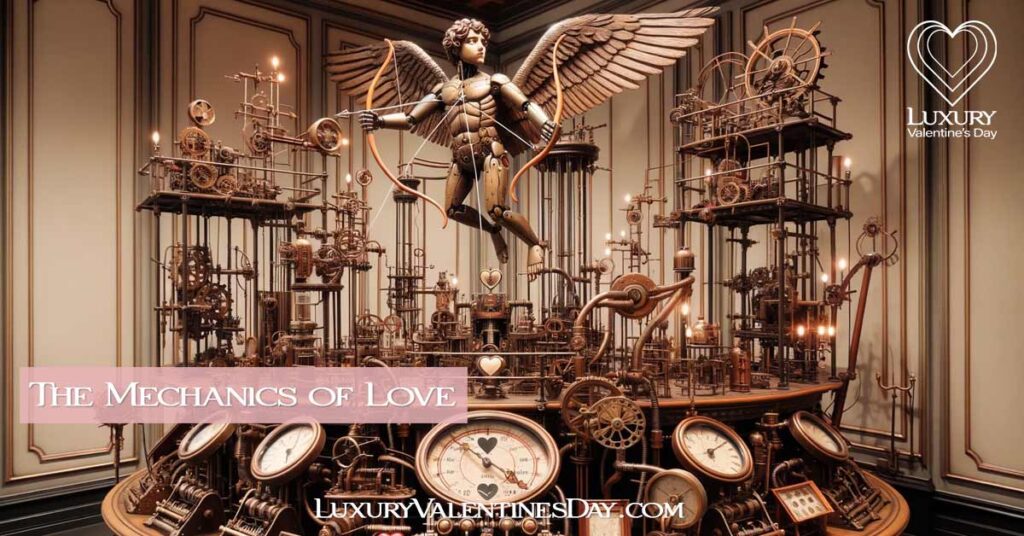
Why does Cupid shoot arrows? It’s a question that’s captivated our imagination for centuries. Is it just a poetic metaphor, or is there a deeper meaning behind this celestial archery? Let’s aim for the heart of the matter.
The Symbolic Significance
First off, the arrow is a powerful symbol. It’s swift, it’s precise, and once it’s released, it’s irreversible—much like love itself. The arrow embodies the idea that love can strike us suddenly and change our lives in an instant.
The Mythological Context
In mythology, Cupid’s arrows come in different types—golden arrows to incite love and leaden arrows to repel it. This duality adds a layer of complexity, showing that love isn’t just about attraction; it’s also about choice and consequence.
The Psychological Angle
From a psychological perspective, the arrow can be seen as a representation of emotional vulnerability. To be struck by Cupid’s arrow is to open oneself up to the possibilities—and risks—of love. It’s a transformative experience that affects us on a deep emotional level.
The Cultural Impact
Cupid’s arrows have permeated our culture in various ways. They appear in art, literature, and even in the language we use to describe love—”love-struck,” “arrow through the heart,” and so on. It’s a testament to the enduring power of this symbol.
The Mechanics Behind Cupid’s Arrows
| Aspect | Details |
|---|---|
| Symbolic Significance | Represents sudden, irreversible love |
| Mythological Context | Golden and leaden arrows |
| Psychological Angle | Emotional vulnerability |
| Cultural Impact | Appears in art, literature, and language |
Why does Cupid shoot arrows? It’s more than just a charming detail; it’s a rich symbol that encapsulates the complexities, vulnerabilities, and transformative power of love. It’s a mechanic that makes us ponder, feel, and most importantly, love.
Conclusion
So, there you have it—a deep dive into the world of Cupid, love’s most iconic messenger. From the myths that shaped his character to the symbolism that defines him, from his influence in art and culture to the mysteries of his own love life, we’ve covered it all.
The Everlasting Allure
Cupid continues to captivate us, not just as a symbol of love, but as a complex character with his own set of paradoxes and ironies. He’s both a god and a vulnerable lover, a cultural icon and a subject of debate. It’s this multi-dimensional aspect that makes him eternally fascinating.
The Takeaways
What can we take away from this exploration?
- The mythology of Cupid enriches our understanding of love and desire.
- His symbolism extends beyond Valentine’s Day and permeates our culture.
- The art and literature inspired by Cupid are as varied as they are impactful.
- The mysteries and ironies of his love life make him relatable and endlessly intriguing.
Key Insights into Cupid
| Cupid Topics | Key Insight |
|---|---|
| Mythology | Adds depth to our understanding of love |
| Symbolism | More than just a Valentine’s Day icon |
| Art & Culture | A subject that inspires varied and impactful works |
| Love Life | A complex character with relatable experiences |
Whether you’re a hopeless romantic or a curious skeptic, there’s something in the story of Cupid for everyone. He’s not just a figure of mythology or a Valentine’s Day mascot; he’s a reflection of our own complexities, vulnerabilities, and aspirations in love.
Frequently Asked Questions (FAQs) About Cupid
Got questions about Cupid? You’re not alone! Here, we tackle some of the most frequently asked questions about love’s most iconic messenger.
Q: Who is Cupid and what did he do?
A: Cupid is the Roman god of love and desire. He’s famous for shooting arrows to make people fall in love. In Roman mythology, he’s the son of Venus, the goddess of love.
Q: What is the job of a Cupid?
A: Cupid’s primary job is to instigate love and desire. He shoots his magical arrows to make people fall head over heels for each other. It’s a full-time gig, and he’s been at it for centuries!
Q: What did Cupid do in Greek mythology?
A: In Greek mythology, Cupid is known as Eros and is the son of Aphrodite. He performs a similar role, wielding arrows that cause people to fall in love.
Q: What is the story of Cupid about?
A: The most famous story about Cupid is his love affair with Psyche, a mortal woman. Their love story is filled with trials, tribulations, and ultimately, eternal love.
Q: What are Cupid’s 3 important powers?
A: Cupid’s three main powers are:
- Shooting arrows that cause love or indifference.
- Flying with his winged sandals.
- Being irresistibly charming.
Q: What are Cupid’s powers?
A: In addition to causing love or indifference, Cupid is also said to have the power to instigate desire and passion, making him a complex deity with a range of abilities.
Q: Is Cupid male or female?
A: Cupid is generally portrayed as male, although interpretations can vary. In Roman mythology, he’s the son of Venus, the goddess of love.
Q: Has Cupid ever fallen in love?
A: Yes, Cupid has fallen in love, most notably with Psyche. Their love story is one of the most famous tales in mythology and highlights the complexities and vulnerabilities even gods face when it comes to love.
Related Posts
- Cookies Decorating Ideas with Edible Flowers: Beautiful Ideas and Tips
- Gilded Decorated Cookie Ideas: Add a Touch of Luxury to Your BakingGilded Edges To Cookies
- 100 Cheap Date Ideas For Valentine’s Day 2025 That Spark Romance
- Propose Day – February 8: A Day to Remember
- Transform Your Kitchen with Romantic Valentine’s Day Table Decor Ideas
- Valentine’s Day Living Room Decor: Transform Your Space with LoveValentine’s Day Living Room Decor













